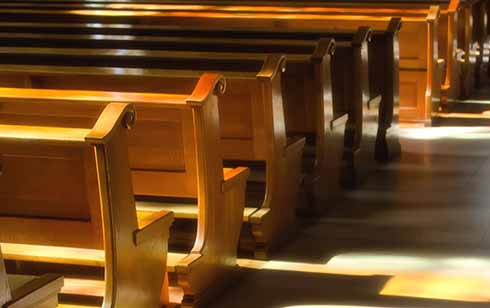 The doors of the small Victorian church are small but solid. They have stood firmly in place for more than a century, and clearly have every intention of doing so for another century, despite the chunks and chips lost or worn by the patient years of opening and closing.
The doors of the small Victorian church are small but solid. They have stood firmly in place for more than a century, and clearly have every intention of doing so for another century, despite the chunks and chips lost or worn by the patient years of opening and closing.
The bluestone steps I tread are smoothed and worn to a dip in the centre of each one by the passage of thousands before me. Eager feet, stepping into a wedding, or a baptism, sad feet, treading heavily with the burden of sorrow, stately feet, leading the procession, humble feet, limping feet, proud feet, feet beautiful and feet broken, little feet. All the feet of those who follow the Way of the Cross.
Inside, the plain wooden pews are gilded with the late afternoon sunlight, filtering through the small Gothic windows, and a crucifix hangs above the altar. The red sanctuary light gleams beside the tabernacle. There are two large vases of garden flowers, a gentle gift of praise.
A Catholic landscape
All is swept, polished and seemly. A statue of the Sacred Heart, and one of Our Lady in her blue mantle stand on either side of the sanctuary, touches of brightness against the pale walls. Above, the high rafters support a wooden ceiling. This is the landscape of my faith. These elements have created a space in which the daily dramas of the life of the community of faith play out down the years.
Week by week, season by season, year by year, in this small part of the great world, Easter candles have been lit from the new fire, funerals have sung our beloved dead home, pilgrims and soldiers and newlyweds have been blessed on their way, secrets – sorrowful and glad – have been placed in the Lord’s merciful hands. Babies have been baptised.
Give us this day our daily bread, we pray. Forgive us. Bless us.
I enter, stepping into the space with the same unconscious familiarity of one who comes home. I select a place carefully – although all places are equal, yet there are some places which seem more right for me to sit than other places. Sometimes it might be before Our Lady. At other times, close to the door, for I must soon be gone. Or I might be drawn close to the sanctuary. There is a private inner freedom I attend to, a silent invitation to make myself at home.
There are those for whom this space holds nothing. They enter, look around briefly, and leave. There are others for whom this is not an emotionally blank space. It carries associations. There are generations of prayer imbued here.
As the Irish poet, John O’Donahue reminds us, in thin places, ‘Absence is alive with hidden presence . . . nothing is ever lost or forgotten.’
A space of comfort
I choose my place and sit. There is a faintly spicy scent of old pine and frankincense, and the small sounds of the building. A distant bird sings. I am comfortable here – my hands quiet, my feet still.
In times past, in the perilous centuries that followed the fall of Rome, when churches as we understand them were first built, these thick walls and small windows made a place of refuge against violent attack. And later, the laws of sanctuary provided protection for the hard-pressed felon who fled to the foot of the altar.
‘It is strange to be here,’ writes O’Donahue. ‘The mystery never leaves you alone. Behind your image, below your words, above your thoughts, the silence of another world waits.’
Sitting here, tiny motes dancing in the shaft of light behind the altar, time stills in the quiet.
Sometimes I have come here on urgent matters. My heart is fluttering. ‘Dear Lord, please don’t let it be. Please keep them safe, Lord. Please let all be well. Remember, oh most gracious. . .’ the words tumble. Gradually, my heart is eased. So many before me have sat here and found sanctuary.
Paying a visit
Sometimes, I come here because I am drawn here. Not much is said or thought. I just feel like ‘paying a visit’. I might remember the people I love in this world, and bless them. I might place some hopeless tangle in the hands of Our Lady Untangler of Knots.
I might be just sitting. And always I find what the poet goes on to say about the thin places we call home.
‘To be holy is to be home, to be able to rest in the house of belonging that we call the soul.’
I stand. I genuflect. I leave.
Outside, nothing has changed. All is as it was. But I have changed. My soul is soothed.
Go in peace to love and serve the Lord.
Thanks be to God.